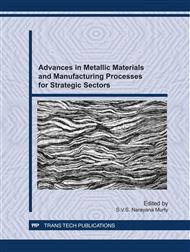p.563
p.569
p.575
p.581
p.588
p.594
p.603
p.608
p.614
Analysis of Trace Additives in Copper Alloys for Space Applications: A Comparison between Graphite Furnace Atomic Absorption Spectrometry and Inductively Coupled Plasma Atomic Emission Spectrometry
Abstract:
Cu-Cr-Zr-Ti alloy is a special type of copper alloy being used as thrust chamber material in cryogenic engine, owing to its good thermal conductivity and mechanical properties at high temperature. Presence of alloying elements like chromium, zirconium and titanium in lower percentage has considerable effect on the thermal and mechanical properties of the thrust chamber material. Hence the accurate estimation of alloying elements as well as trace impurities is an important part of the quality control process in the manufacture of these materials. In analytical methods like XRF, F-AAS etc. which are used for chemical analysis of alloys, the intensity of analytical signal is highly dependent on matrix composition and hence precise matching of sample and standard matrices is required for drawing accurate results. ICP-AES is well-established analytical technique offers better detection limit, wide linear dynamic range, high precision, good accuracy, and practically negligible chemical interferences for the estimation of alloying elements. An accurate and precise technique for quantitative estimation of the elements viz. chromium, zirconium, titanium, iron, manganese, nickel, lead etc. in Cu-Cr-Zr-Ti alloy has been successfully developed using ICP-AES and GF-AAS. Merits and demerits of the two analytical techniques are also compared with respect to the result obtained.
Info:
Periodical:
Pages:
588-593
Citation:
Online since:
January 2012
Keywords:
Price:
Сopyright:
© 2012 Trans Tech Publications Ltd. All Rights Reserved
Share:
Citation:


